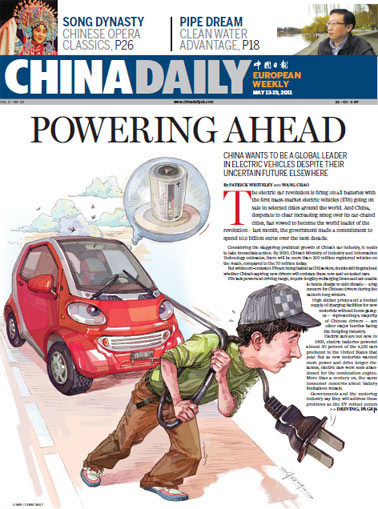Green China
Powering up new energy partnership
Updated: 2011-01-25 15:07
By Lin Boqiang (China Daily)
The development of the new energy industry has moved high up the agenda of many countries in the face of the common threats of global climate change and energy insecurity.
For China, with its accelerating process of industrialization and urbanization, continued development is challenged by its scarcity of resources, energy shortages and the rising costs of energy, etc. The development of the new energy industry would help ease the energy shortage and facilitate China's shift toward low-carbon economic growth.
| ||||
Obviously, the new energy sector concerns the common interests of the two countries. The great market potential of China and the leading technology of the US make the two countries complementary, laying a solid foundation for bilateral cooperation.
Indeed, bilateral cooperation between the two in this field is inevitable. After decades of research and experiment, the US leads the world in new energy technology, and it has widely put its technology and energy-saving management mode into practice. However, as a mature economy, the US has stable energy supply and demand and thus cannot apportion a large share to new energy in the short run. Therefore, in order to continue new energy technology research and development, the US has to turn its attention to the overseas market.
China's demand for energy is still increasing and it is making big efforts to direct its development mode onto a sustainable path through the promotion of new energy.
In fact, China is not a barren wilderness for new energy sources, it is abundant in solar and wind energy. China will be a bountiful pasture for new energy as long as it can break the technology bottleneck. China's present low-end energy consumption means not only great potential for energy saving and emissions reduction, but also a huge market for technological experiment.
Viewed in this light, it is mutually beneficial for China and the US to work together in the new energy sector, especially on new technology. The second China-US Strategic and Economic Dialogue in May, 2010 secured 26 agreements, almost half of which were on clean energy. This shows that the two economies share many common interests and can reach consensus.
As the two largest economies with huge energy consumption and carbon emissions, close partnership between China and the US would send a positive message to the global community.
However, there is still a gulf separating the two countries. The US still prefers to keep China at arm's length. It exports its management mode and mature technology, while retaining its technology. What China requires in order to pursue sustainable development is for the US to transfer some of its core technology. Thus, inevitably, core technology transfer has become a bone of contention between the two countries.
Last year, Washington initiated a Section 301 Trade Act investigation into China's clean energy sector, following claims by the United Steelworkers Union in the US that policies adopted by China to stimulate and protect its clean energy industry are inconsistent with its World Trade Organization obligations.
In fact, this is just one of the recurring trade disputes between the two countries. To a degree the move is understandable.
In response, China should accelerate the legislative process to oversee the development of the new energy sector, make full use of its market potential and quickly upgrade the industry to the international level. It should also make greater efforts to strengthen its research and development, improve environmental protection and raise the safety standards of the industry.
Given their different stages of development, the trade disputes between China and the US are unavoidable and will remain so in the long run, but they should not allow such disputes to adversely affect cooperation between the two economies.
Both countries should deal with the trade disputes with patience and rationality, and solve their disagreements through dialogue and negotiation and within the framework of international rules and bilateral agreement.
After all, both have to conform to the world trend of cooperation and common development, and what they should bear in mind is that the fundamental aim of cooperation is to achieve win-win results.
The author is a professor with China Energy Economy Research Center of Xiamen University.
E-paper

War of the roses
European Chinese rose growers are beating their Chinese rivals at their own game
Preview of the coming issue
High-tech park gets big boost
At the source
Specials

New wave
Coastal city banks on marine sector to ride next stage of economic development

Drunk driving
Drunk drivers face a detention for one to six months and a revokation of their drivers' license.

V-Day parade
A military parade marking the 66th anniversary of the Soviet victory over Nazi.




